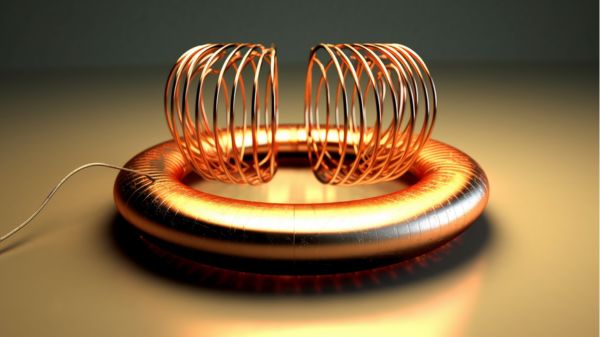Have you ever wondered why magnetism is crucial in renewable energy advancements? Well, let me tell you, it’s because magnets play a vital role in various green energy technologies.
For instance, in wind power and hydropower, magnets are used in generators to convert mechanical energy into electricity. This not only improves reliability and lowers maintenance costs but also increases efficiency in these systems.
Moreover, magnets, like magnetrons, optimize the manufacturing process of solar panels, making them more efficient in harnessing the power of the sun. Even in geothermal power, magnets are used in turbines to convert thermal energy into electrical energy.
By harnessing the power of electromagnetism, renewable energy sources become more efficient and reliable, propelling us towards a sustainable future.
Magnetic Field Generation and Renewable Energy
We believe that the generation of magnetic fields plays a vital role in the advancement of renewable energy.
Magnetism is a key element in renewable energy technologies that rely on electromagnetic induction for energy generation. One such technology is wind turbines, which utilize strong rare-earth magnets to convert the kinetic energy from spinning blades into electrical power. By eliminating the need for a gearbox and reducing weight, these magnets improve efficiency and lower maintenance costs.
In hydropower, magnets are used to produce clean power by rotating past copper coils. Magnetic gearboxes can also optimize the kinetic energy of water in smaller channels, reducing costs. Additionally, tidal energy harnesses the moon’s gravitational forces with the help of magnets to generate electricity.
Magnetism’s Impact on Energy Conversion Efficiency
Our research shows that magnetism significantly impacts the energy conversion efficiency of renewable technologies.
In renewable energy advancements, magnetism plays a crucial role in improving the efficiency of various renewable energy technologies such as solar power, wind turbines, and hydroelectric power.
Magnetic energy storage systems, for example, utilize magnetism to store and release energy efficiently. The electromagnetic properties of magnets enable the conversion of mechanical energy into electrical energy in wind turbines and hydroelectric power plants.
Magnets also enhance the efficiency of solar power generation by optimizing the deposition process in the manufacture of solar panels. By rotating magnets past copper coils, hydropower turbines produce clean power while maximizing energy conversion efficiency.
Magnetic Materials Used in Renewable Energy Technologies
In exploring the role of magnetism in renewable energy advancements, let’s now delve into the magnetic materials utilized in various renewable energy technologies. Magnetic materials play a crucial role in the development of sustainable energy solutions and power generation. By harnessing the power of magnetism, these materials enable efficient energy conversion and facilitate the generation of electricity from renewable sources.
The interaction between magnetic fields and electromagnetic waves, known as electromagnetism, is at the heart of many renewable energy technologies. For instance, in wind turbines and hydropower systems, rare-earth magnets are used to convert the mechanical energy of spinning blades or flowing water into electrical energy. Similarly, solar panels incorporate magnetrons to optimize the deposition process and enhance overall efficiency.
In geothermal power, magnets are integral in turbines, where they convert the mechanical energy produced by expanding hot fluid into electrical currents. Thus, magnetic materials are essential components in renewable energy technologies, enabling the development of sustainable and efficient power generation systems.
Role of Magnetism in Enhancing Power Generation
Magnetism plays a pivotal role in maximizing power generation efficiency. The use of magnetic technologies in renewable energy applications has the potential to revolutionize the way we generate electricity. Here are four ways in which magnetism enhances power generation:
- Improved Efficiency: Magnetic materials, such as permanent magnets, enable the conversion of mechanical energy into electric energy with high efficiency. This means that more of the energy from renewable sources, such as wind or water, can be harnessed and converted into usable electricity.
- Optimized Power Generation: Magnets help optimize power generation in various renewable energy technologies. For example, in wind turbines, permanent magnet synchronous generators eliminate the need for gearboxes, reducing weight and improving reliability. In hydropower turbines, magnets optimize the kinetic energy in smaller channels, enabling the generation of electricity from flowing water.
- Enhanced Manufacturing Processes: Magnets play a crucial role in the manufacture of solar panels. Magnetrons, which are permanent magnet assemblies, enhance the deposition process, improving the efficiency and utilization of target materials. This leads to more efficient solar panels and a higher potential for sustainable energy generation.
- Temperature Stability: In geothermal power, magnets are utilized in turbines to create electrical currents from the mechanical energy produced by expanding hot fluid. Magnets can be optimized for temperature stability, ensuring consistent power generation even in extreme conditions.
Future Advancements in Magnetism-Based Renewable Energy
As we look ahead, we can anticipate exciting advancements in renewable energy that are based on the power of magnetism. Solar and wind turbines use magnetic technologies to convert mechanical energy into electrical energy, making them more efficient and reliable. These renewable energy sources play a pivotal role in reducing greenhouse gas emissions and mitigating climate change.
Electromagnetic energy harvesting systems, such as magnetic refrigeration, offer innovative solutions for cooling and heating applications, reducing the reliance on traditional energy sources. Furthermore, magnets are crucial in geothermal power plants, where they optimize temperature stability and magnetic properties to generate electricity from the mechanical energy produced by expanding hot fluid.
Tidal power is another area where magnets can be utilized to harness the kinetic energy of ocean tides, providing a reliable and consistent source of electromagnetic-based renewable energy. These advancements in magnetism-based renewable energy have the potential to revolutionize the way we generate and consume electricity, paving the way for a greener and more sustainable future.
Conclusion
Magnetism plays a crucial role in renewable energy advancements by improving efficiency, reliability, and cost-effectiveness in various green energy technologies. While some may argue that the initial investment in magnet-based systems is high, the long-term benefits far outweigh the costs.
By harnessing the power of magnets, we can accelerate the transition towards a sustainable future, ensuring a cleaner and more efficient energy landscape for generations to come.




